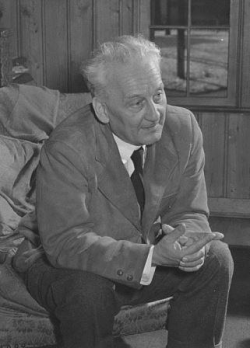Albert Szent Gyorgyi

- Born
- 16 September 1893
- Died
- 22 October 1986 (age 93)
Albert Szent-Gyorgyi was a Hungarian physiologist who won the Nobel Prize in Physiology and Medicine in 1937. He was the first to isolate vitamin C and his research on biological oxidation provided the evidence for the citric acid cycle. Moreover, his research into muscular contraction shed light on the field of muscle research. Szent-Gyorgyi was very interested in cancer, and was one of the first scientists to explore the connections between free radicals and cancer.
Szent-Gyorgyi was born on the 16th September 1893 in Budapest, Hungary. He studied in his uncle’s laboratory until the outbreak of the first world war when he joined the army and served on the Italian and Russian fronts. He was awarded a Silver Medal for valour. He was wounded in action and was discharged in 1917.
Szent-Gyorgyi completed his medical degree in Budapest in 1917, and became interested in biochemistry, pursuing biochemical studies in Germany and the Netherlands.
In 1928 at the Mayo Foundation in Rochester, USA, he found an organic reducing agent, which he named hexuronic acid from adrenal gland extracts and plant juices. Hexuronic acid is now known as ascorbic acid, and four years later at the University of Szeged in Hungary, he was part of a team that proved that hexuronic acid was identical to vitamin C, which was discovered in 1907 by Axel Holst and Alfred Forhlich.
After this discovery, he focussed on researching the organic compounds that helped to break down carbohydrates into carbon dioxide. Two years later, his research aided Air Hans Krebs investigated the complete conversion cycle of citric acid.
Szent-Gyorgyi then concentrated on the biochemistry of muscular contraction, and discovered ‘actin’, a protein that when in combination with the muscle protein myosin, is responsible for muscular contraction. He also showed that the compound adenosinie triphosphate (ATP) is the source of energy that immediately drives muscle contraction.
Discovery consists of looking at the same thing as everyone else and thinking something different.
Attributed to Szent-Györgyi in: IEEE (1985) Bridging the present and the future: IEEE Professional Communication Society conference record, Williamsburg, Virginia, October 16-18, 1985. p. 14.
Szent-Gyorgyi then moved to the US, where he took up the post of director of the Institute of Muscle Research in Massachusetts, where he led a team studying cell division and cancer.
Szent-Gyorgyi was an active anti-Nazi campaigner during the 1930’s and during the first world war he became a Swedish citizen and was helped by the Swedish Embassy in Budapest.



